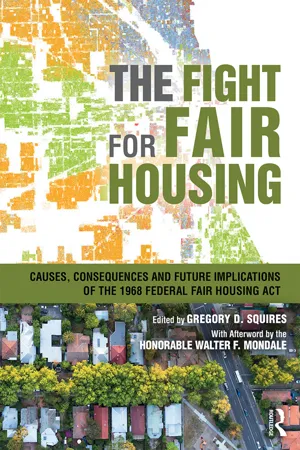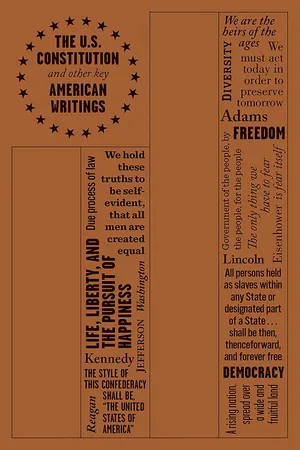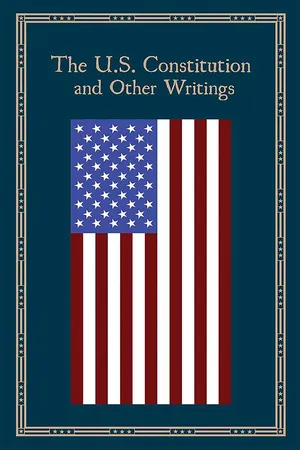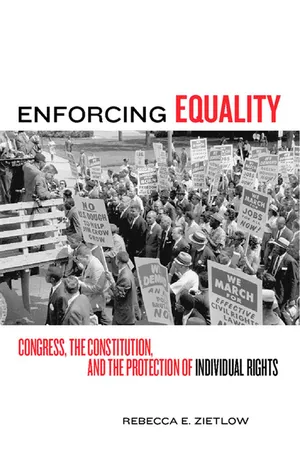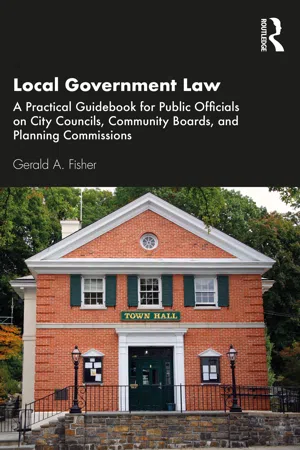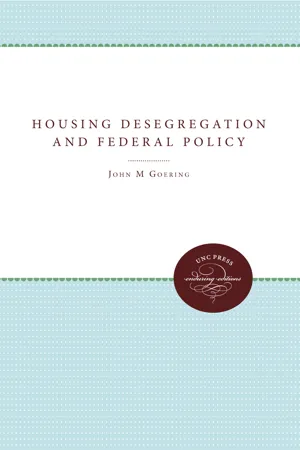Politics & International Relations
Civil Rights Act of 1968
The Civil Rights Act of 1968, also known as the Fair Housing Act, aimed to address housing discrimination by prohibiting the refusal to sell or rent a dwelling to any person based on their race, color, religion, or national origin. It also made it a federal crime to "by force or by threat of force, injure, intimidate, or interfere with anyone" exercising their fair housing rights.
Written by Perlego with AI-assistance
Related key terms
8 Key excerpts on "Civil Rights Act of 1968"
- eBook - ePub
- Lawrence M. Salinger(Author)
- 2013(Publication Date)
- SAGE Publications, Inc(Publisher)
FFair Housing Act
The Fair Housing Act (FHA) became law in 1968, upon the passage of the Civil Rights Act of 1968. The definition and laws related to fair housing made up Title VIII of the Civil Rights Act. Prior to 1968, the only law governing fair housing was the Civil Rights Act of 1866, which included language that only alluded to fair housing and had no details about federal enforcement. The impetus for the law came from post–World War II growth of suburbia and attempts by realtors to restrict the purchase of homes on the basis of race. The Supreme Court had already ruled against the legality of covenants to segregate neighborhoods in 1948, and in 1964, it ruled against Proposition 14 in California, which sought to deny equal access to housing. In the decision of Reitman v. Mulkey (1967), the Court ruled that the proposition violated the Fourteenth Amendment. On the federal level, the Civil Rights Act of 1964 also made some provisions for fair housing but lacked federal enforcement guidelines.The Civil Rights Act of 1968 corrected the problems of the 1964 legislation by detailing enforcement provisions in Title VIII, titled the Fair Housing Act. Prior legislation addressed the public rights of nonwhites, whereas the 1968 law specifically addressed the private housing market. Initially, the act prohibited landlords, realtors, and others who sold, leased, or rented property from denying approval because of race, color, religion, sex, or national origin. Further, these discriminatory terms could not be included in contracts or advertisements for dwellings. The act also forbade the use of coercion, threats, or similar actions that prevent or interfere with a person’s right to fair housing. Exceptions include owner-occupied buildings with less than four units, houses rented or sold by the owner without a realtor, and properties owned by organizations or clubs requiring membership for occupancy. Mortgage lenders cannot take certain actions based upon race, color, national origin, religion, and sex. Persons cannot be denied information about loans or be denied for a mortgage loan or a purchased loan based on the protected categories. - eBook - ePub
The Fight for Fair Housing
Causes, Consequences, and Future Implications of the 1968 Federal Fair Housing Act
- Gregory D. Squires(Author)
- 2017(Publication Date)
- Routledge(Publisher)
(Remarks on Signing the Civil Rights Act, Lyndon B. Johnson, April 11, 1968)With that, the Civil Rights Act of 1968 officially became the law of the land.The Fair Housing Amendments Act
While the passage of the Fair Housing Act was an undeniable civil rights victory, the true cost of the Dirksen Compromise would soon become clear. Without any significant enforcement power, HUD was incapable of doing anything other than attempting to reach a voluntary conciliation between parties. Private lawsuits and a small number of pattern-or-practice cases brought by the DOJ were not able to fill the void left by the lack of an administrative enforcement mechanism. Enforcement of state and local fair housing laws was spotty: whether or not the laws were enforced in a particular jurisdiction often depended upon whether any committed, experienced lawyers were willing to bring cases.As a result, in the decades to follow, the FHA would fail to live up to its promise to end housing discrimination and foster integrated living patterns. Residential segregation rates remained unacceptably high throughout the 1980s, a situation which scholars likened to apartheid. A 1979 national study by HUD found that housing discrimination was still pervasive. The study estimated that two million acts of housing discrimination took place each year (in contrast with just 5,000 complaints filed annually). It also found the probability of a black homeseeker experiencing discrimination was approximately 75 percent in the rental market and 62 percent in the sales market (Wienk et al. 1979: 64). As one commentator later noted, “Of all the civil rights battles fought during the last three decades, only housing discrimination appears to remain totally unabated, entrenched, and impervious to public policy and civil rights enforcement” (Kushner 1989: 1050).The coverage of the FHA remained an issue as well. The law included only race, color, religion, and national origin as protected characteristics. As the ensuing years would show, other categories of people were also in need of civil rights protections in housing. - Founding Fathers(Author)
- 2015(Publication Date)
- Canterbury Classics(Publisher)
THE CIVIL RIGHTS ACT (1964) __________ In June 1963, President John F. Kennedy proposed that the United States adopt a sweeping civil rights law that would prohibit segregation in all public places and of all public facilities, would prohibit restrictions to voting rights, and would prohibit employment discrimination based on race, color, sex, religion, or national origin. After Kennedy’s assassination in 1963, President Lyndon B. Johnson continued to fight for the legislation. He faced much opposition in Congress, including a Senate filibuster, but the Civil Rights Act finally became law on July 2, 1964. A n act To enforce the constitutional right to vote, to confer jurisdiction upon the district courts of the United States to provide injunctive relief against discrimination in public accommodations, to authorize the Attorney General to institute suits to protect constitutional rights in public facilities and public education, to extend the Commission on Civil Rights, to prevent discrimination in federally assisted programs, to establish a Commission on Equal Employment Opportunity, and for other purposes. Be it enacted by the Senate and House of Representatives of the United States of America in Congress assembled, That this Act may be cited as the “Civil Rights Act of 1964”. T ITLE I V OTING R IGHTS S EC. 101. Section 2004 of the Revised Statutes (42 U.S.C. 1971), as amended by section 131 of the Civil Rights Act of 1957 (71 Stat. 637), and as further amended by section 601 of the Civil Rights Act of 1960 (74 Stat- eBook - ePub
- (Author)
- 2017(Publication Date)
- Canterbury Classics(Publisher)
THE CI VIL RIGHTS AC T (1964) In June 1963, President John F. Kennedy proposed that the United States adopt a sweeping civil rights law that would prohibit segregation in all public places and of all public facilities, would prohibit restrictions to voting rights, and would prohibit employment discrimination based on race, color, sex, religion, or national origin. After Kennedy’s assassination in 1963, President Lyndon B. Johnson continued to fight for the legislation. He faced much opposition in Congress, including a Senate filibuster, but the Civil Rights Act finally became law on July 2, 1964. A n act To enforce the constitutional right to vote, to confer jurisdiction upon the district courts of the United States to provide injunctive relief against discrimination in public accommodations, to authorize the Attorney General to institute suits to protect constitutional rights in public facilities and public education, to extend the Commission on Civil Rights, to prevent discrimination in federally assisted programs, to establish a Commission on Equal Employment Opportunity, and for other purposes. Be it enacted by the Senate and House of Representatives of the United States of America in Congress assembled, That this Act may be cited as the “Civil Rights Act of 1964”. T ITLE I V OTING R IGHTS S EC. 101. Section 2004 of the Revised Statutes (42 U.S.C. 1971), as amended by section 131 of the Civil Rights Act of 1957 (71 Stat. 637), and as further amended by section 601 of the Civil Rights Act of 1960 (74 Stat - eBook - ePub
Enforcing Equality
Congress, the Constitution, and the Protection of Individual Rights
- Rebecca E Zietlow(Author)
- 2006(Publication Date)
- NYU Press(Publisher)
5To Secure These Rights
The 1964 Civil Rights ActDuring the New Deal, most members of Congress avoided addressing issues of racial justice. However, shortly after the New Deal political actors, including some northern state legislatures and members of the federal Executive branches, became actively engaged in fighting racial discrimination.1 For institutional reasons, Congress took considerably longer to act. However, as a civil rights movement grew and flourished following World War II, political momentum turned in favor of civil rights. In 1957 and 1960 Congress enacted relatively ineffective voting rights measures, but when members of Congress acted decisively in 1964, that legislation had a significant impact. The passage of the 1964 Civil Rights Act was one of the most momentous events in the expansion of rights of belonging in American history.2 The public debate surging in the streets made its way into Congress. The battle in Congress over the act was fierce, and it paralyzed Congress for almost a year. However, it was ultimately successful. Unlike other eras in which Congress acted to expand rights of belonging, this time Congress had help from the Supreme Court. The Court and the majority of members of Congress agreed that it was necessary to outlaw race discrimination. The Supreme Court preceded Congress with its 1954 ruling outlawing state-mandated segregation in Brown v. Board of Education .3 The Court’s ruling in Brown is often cited as the prime example of the Court acting to protect minority rights.4 However, in 1964, members of Congress responded to the will of the majority when they enacted the strongest legislative protections for rights of belonging since the Reconstruction Era.Like the Civil Rights Act of 1875, its Reconstruction Era predecessor from almost one hundred years before, Title II of the 1964 act prohibits race discrimination in places of public accommodation. Title VII of the 1964 act also prohibits discrimination on the basis of race, color, sex, or religion in employment,5 and Title VI prohibits race discrimination by recipients of federal funds.6 The act also included important provisions authorizing the U.S. Department of Justice to enforce its antidiscrimination mandates.7 - eBook - ePub
- Steven W. Bender, Raquel Aldana, Gilbert Paul Carrasco, Joaquin G. Avila(Authors)
- 2015(Publication Date)
- Routledge(Publisher)
3 Discrimination in Housing Landlord DiscriminationAlthough the purchase of housing will also be discussed to some extent in this chapter, the focus will be primarily on the rental of housing. Latino/as are more likely than others to have the following characteristics associated with lower home-ownership rates:• householder is not a citizen; • householder is foreign-born; • foreign-born householder recently arrived in the United States; • young householder; • low income; • low educational attainment level; • residence located in central city; • residence in multifamily housing unit;• residence in high-cost housing market.1Many of the cases discussed in this chapter relate to African Americans, but a study conducted by the U.S. Department of Housing and Urban Development (HUD) reveals that discrimination against Hispanic renters has become more common than discrimination against African Americans.2The Civil Rights Act of 1964, although fairly comprehensive, did not prohibit private discrimination in housing. The need for such a provision became clear to Congress, however, in subsequent years, especially as young African Americans and Latino/as returned from fighting in Vietnam only to be denied housing because of their race. The assassination of Dr. Martin Luther King Jr. on April 4, 1968, helped spur Congress into action, and the Civil Rights Act of 1968 was enacted a week later. As amended, Title VIII (8) of the 1968 law, also known as the Fair Housing Act (FHA), prohibits discrimination in housing based on race, color, national origin, and familial status, among other categories.At about the same time Congress enacted Title VIII, the Supreme Court revived a federal remedy for violations of the housing discrimination provision of the post–Civil War Civil Rights Act of 1866, 42 U.S.C. § 1982 (Jones v. Alfred H. Mayer Co - eBook - ePub
Local Government Law
A Practical Guidebook for Public Officials on City Councils, Community Boards, and Planning Commissions
- Gerald A. Fisher(Author)
- 2021(Publication Date)
- Routledge(Publisher)
Chapter 7Fair HousingProviding access to decent housing for all, free of discrimination, has long been an important objective in the United States, an objective that has escaped full realization in spite of considerable attention.Traditionally, for purposes of providing an adequate assurance of lawful and decent housing, communities often understood this to involve local government enforcement of zoning and construction code regulations. While such enforcement continues to be relevant, it has become well-recognized that lawful and decent housing requires more comprehensive action in order to resolve the problem of housing segregation that remains in our country. Perhaps the most pervasive additional effort at addressing this issue is embodied in a federal law known as the Federal Fair Housing Act (42 U.S.C. 3601 et seq.) which broadly declared in 1968 that it is “the policy of the United States to provide, within constitutional limitations, for fair housing throughout the United States.” In 1988, the Fair Housing Amendments Act expanded its protections.The Federal Fair Housing Act (or “FHA”) will be the focus of this chapter. The discussion will first consider an historical context, focused on the first half of the 1900s, when the problem of housing segregation took a turn for the worse during the two World Wars, as well as the period after World War II, when the problem was exacerbated as metropolitan areas were created throughout the country. We will then focus on three specific areas of activity in which local governments can become targets for legal action under FHA regulations, thus making the FHA relevant to local officials. The discussion will finally turn to a review of court decisions which discuss the manner in which claims are made against local governments, and reviewed by the courts, under the FHA. - eBook - ePub
- John M. Goering(Author)
- 2012(Publication Date)
- The University of North Carolina Press(Publisher)
In an interview that appeared on page one of the Washington Post, William Bradford Reynolds, assistant U.S. attorney general for civil rights, was reported to have said that Congress intended Title VIII only to prohibit racial bias in renting or selling housing, and, as long as people are not denied free choice of housing, “I don’t think any government ought to be about the business to reorder society or neighborhoods to achieve some degree of [racial] proportionality” in housing. 39 Jane Lang McGrew, former general counsel of HUD (author of the opinion referred to above), shot back four days later in a Los Angeles Times column that Reynolds was engaged in “revisionist thinking” about Title VIII. There are two purposes of the law, she wrote, “to eliminate discrimination and to promote integration in housing.” Stopping with the first, as Reynolds did, “doesn’t go as far as Congress went, and it is nowhere close to where the courts have been,” McGrew said, citing Supreme Court statements about the strong national commitment to promote integrated housing reflected in the law. 40 In an analysis entitled “Nation’s Policy on Integration at Crossroads,” the Washington Post staff writer who had interviewed Reynolds concluded that if “Reynolds succeeds in greatly narrowing the interpretation of the Fair Housing Act... residence patterns in the nation will be profoundly changed.” 41 A different approach to the question of whether municipal race-conscious counseling violates Title VIII focuses on the reference to constitutional limitations in the purpose clause of Title VIII: “It is the policy of the United States to provide, within Constitutional limitations, for fair housing throughout the United States.” The phrase “Constitutional limitations” suggests that Congress wished constitutional principles to play a major role in determining the validity of fair housing programs
Learn about this page
Index pages curate the most relevant extracts from our library of academic textbooks. They’ve been created using an in-house natural language model (NLM), each adding context and meaning to key research topics.

